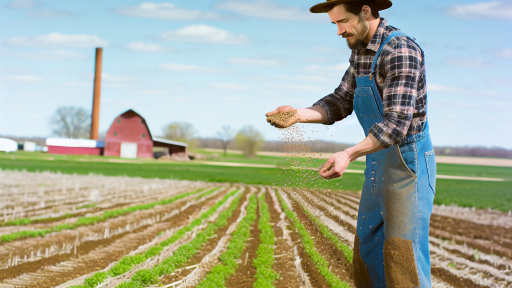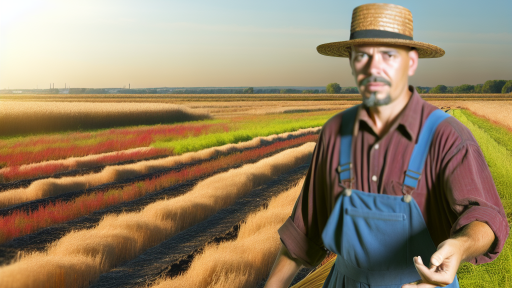Introduction to Cover Crops and Water Retention
Cover crops play a crucial role in sustainable agriculture.
They improve water retention in soil effectively.
Farmers utilize cover crops to enhance soil quality.
These crops also prevent soil erosion and nutrient loss.
Additionally, they promote biodiversity in ecosystems.
Understanding Cover Crops
Cover crops are plants grown primarily to benefit the soil.
They are usually planted during the off-season.
Common cover crops include clover, rye, and vetch.
Each type offers unique benefits for water retention.
Benefits of Cover Crops on Water Retention
Cover crops enhance soil structure and permeability.
This improvement allows water to infiltrate more effectively.
Moreover, they increase organic matter in the soil.
This organic matter retains moisture more effectively.
In addition, the root systems help create channels in the soil.
Mechanisms of Increased Water Retention
Cover crops capture and hold rainwater in the soil.
Transform Your Agribusiness
Unlock your farm's potential with expert advice tailored to your needs. Get actionable steps that drive real results.
Get StartedThey reduce surface runoff, allowing more water absorption.
Also, they mitigate evaporation from the soil surface.
Plant roots create a sponge-like effect, enhancing water retention.
Long-term Effects on Soil Health
Over time, cover crops contribute to healthier soil biomes.
They foster microbial communities vital for nutrient cycling.
Healthy soil retains water more efficiently under drought conditions.
This resilience supports sustainable farming practices.
Types of Cover Crops Beneficial for Soil Water Retention
Leguminous Cover Crops
Leguminous cover crops enhance soil health effectively.
They fix atmospheric nitrogen, enriching the soil nutrient profile.
Examples of these crops include clover and vetch.
These plants improve soil structure, promoting better water infiltration.
Additionally, their root systems increase soil porosity.
Grasses for Water Retention
Grasses also play a crucial role in retaining soil moisture.
Examples like ryegrass and sorghum are particularly effective.
These cover crops produce dense root systems.
These roots help reduce soil erosion, preserving nutrients.
Furthermore, they create a barrier that slows runoff, enabling more absorption.
Brassicas and Taprooted Crops
Brassica species, like radishes, can improve soil water retention significantly.
Their deep taproots break compacted soil layers.
This enhances drainage and allows better water access for other plants.
Moreover, they can help manage soil moisture levels effectively.
Multi-Species Cover Crop Mixtures
Mixing cover crops offers synergistic benefits for water retention.
Combining legumes, grasses, and brassicas creates diverse root structures.
This diversity improves nutrient cycling and enhances soil structure.
Showcase Your Farming Business
Publish your professional farming services profile on our blog for a one-time fee of $200 and reach a dedicated audience of farmers and agribusiness owners.
Publish Your ProfileOverall, a multi-species approach maximizes water retention potential.
Benefits of Using Cover Crops
Cover crops contribute to improved soil health and fertility.
They enhance moisture retention, which supports plant growth.
Moreover, they reduce the need for synthetic fertilizers.
This practice promotes sustainable agricultural environments.
Mechanisms of How Cover Crops Enhance Soil Structure
Improving Soil Aggregation
Cover crops significantly enhance soil aggregation.
This process occurs as root systems penetrate the soil, aiding structure formation.
Additionally, these plants produce organic matter as they grow.
Decomposing organic matter promotes microbial activity and binding of soil particles.
As a result, this leads to improved soil texture and water retention.
Increasing Organic Matter Content
Cover crops contribute to higher organic matter levels in the soil.
This organic matter serves as a sponge, absorbing moisture effectively.
As the cover crops decompose, they release nutrients into the soil.
Consequently, this process enhances overall soil fertility.
Higher organic matter improves both nutrient supply and moisture-holding capacity.
Reducing Soil Erosion
One of the major functions of cover crops is to minimize soil erosion.
Their roots stabilize the soil, preventing loss during heavy rains.
This protective barrier is vital for maintaining soil health.
By reducing erosion, cover crops help retain soil moisture.
Consequently, the soil surface remains intact, which aids in water infiltration.
Enhancing Water Infiltration
Cover crops create channels in the soil for water to penetrate more easily.
These channels improve the soil’s ability to absorb rainfall and irrigation.
As a result, water can reach deeper layers of soil more efficiently.
This enhances the availability of water for subsequent crops.
Increased infiltration reduces the risk of surface runoff.
Encouraging Soil Microbial Activity
Cover crops foster a thriving ecosystem of soil microorganisms.
They provide organic materials that these microbes utilize for nourishment.
As microbial populations increase, soil health improves overall.
These microorganisms play a key role in nutrient cycling.
Healthy microbial communities enhance nutrient availability and soil structure.
Discover More: Smart Farming Solutions For Crop Monitoring Needs
Impact of Root Systems on Soil Porosity and Water Infiltration
Understanding Root Systems
Root systems play a crucial role in soil health.
They penetrate the soil and create channels for water movement.
This process enhances soil porosity significantly.
As a result, water can infiltrate more readily.
Improving Soil Structure
Cover crops improve soil structure through their roots.
These roots bind soil particles together, creating a stable matrix.
This matrix supports better water retention capabilities.
Consequently, soils become less compact and more aerated.
Enhancing Water Infiltration
Water infiltration is essential for healthy crop growth.
Showcase Your Farming Business
Publish your professional farming services profile on our blog for a one-time fee of $200 and reach a dedicated audience of farmers and agribusiness owners.
Publish Your ProfileRoot channels allow water to move deeper into the soil.
This reduces surface runoff during heavy rain events.
Improved infiltration minimizes erosion risks as well.
Beneficial Microbial Activity
Root systems foster beneficial microbial activity in the soil.
Healthy microbes improve nutrient cycling and organic matter breakdown.
This microbial activity further supports water retention.
Thus, a vibrant soil ecosystem contributes to overall productivity.
Maintaining Soil Moisture
Cover crops help maintain soil moisture during dry periods.
Their root systems preserve moisture by reducing evaporation.
This effect is particularly noticeable in sandy soils.
As a result, farmers can achieve higher yields with less irrigation.
Gain More Insights: Cover Crop Termination Methods for Best Results
The Role of Organic Matter from Cover Crops in Moisture Retention
Enhancing Soil Structure
Cover crops improve soil structure significantly.
They create a network of roots that bind soil particles together.
This binding action reduces soil erosion during heavy rains.
As a result, more water stays in the soil.
Increasing Organic Matter
Another benefit of cover crops is increasing organic matter in the soil.
When cover crops decompose, they add nutrients back to the soil.
This boosts the soil’s capacity to retain moisture over time.
Additionally, organic matter helps improve drainage and aeration.
Improving Soil Biology
Cover crops also enhance microbial activity in the soil.
This increased activity helps break down organic matter more efficiently.
As a result, water retention improves due to healthier soil biology.
Microbial processes also release nutrients that plants need for growth.
Reducing Weed Growth
Cover crops suppress weed growth through competition.
Less weed growth means more resources are available for cover crops.
This leads to better moisture retention as the cover crops thrive.
Providing Ground Cover
Cover crops provide essential ground cover in the off-season.
This protects the soil from harsh environmental conditions.
Effective ground cover reduces evaporation rates from the soil surface.
Consequently, soil moisture remains higher for longer periods.
Learn More: Choosing the Right Hydroponic Setup

Comparative Analysis of Fields with and without Cover Crops
Introduction to Cover Crops
Cover crops play a significant role in agricultural practices.
Farmers adopt these crops to enhance soil health and water retention.
A gradual increase in cover crop use is evident in various farming regions.
Water Retention in Fields with Cover Crops
Fields planted with cover crops exhibit superior water retention.
These crops create a protective layer on the soil surface.
This layer reduces evaporation rates significantly.
Moreover, cover crops improve soil structure.
Enhanced soil structure allows better water infiltration and retention.
Showcase Your Farming Business
Publish your professional farming services profile on our blog for a one-time fee of $200 and reach a dedicated audience of farmers and agribusiness owners.
Publish Your ProfileFor instance, fields managed by agriculturalist Rachel Greene show remarkable results.
Her farm uses clover and rye as cover crops effectively.
Comparison with Fields without Cover Crops
Conversely, fields without cover crops often suffer from poor water retention.
Unprotected soil faces higher evaporation rates in dry conditions.
This leads to moisture loss, affecting crop yield.
In dry seasons, these fields require more irrigation.
A comparison made by Dr. Michael Evers shows stark differences.
His research indicates a 30% increase in water retention in fields with cover crops.
Long-term Benefits of Cover Crops
Over time, the benefits of using cover crops become evident.
Increased organic matter enhances soil fertility.
Furthermore, healthy soils maintain moisture better than those without cover crops.
Farmers can experience enhanced crop yields in the long run.
Studies from various agricultural extensions support these findings.
Case Studies and Real-life Examples
Let’s highlight some notable case studies.
- Ben Murray, a corn farmer, reported a 25% increase in yield.
- Sara Lopez uses cover crops during winter, improving soil moisture.
- David Kim’s vineyard benefits from reduced irrigation costs.
These examples illustrate the practical advantages of adopting cover crops.
Farmers like these contribute to a more sustainable agricultural future.
See Related Content: How to Boost Soil Fertility Naturally on Farms
Best Practices for Selecting and Managing Cover Crops
Understanding Your Goals
Begin by clearly defining your objectives for using cover crops.
Your goals may include improving soil health and increasing water retention.
Consider whether you aim to suppress weeds or add organic matter.
This understanding will guide your selection process.
Choosing the Right Cover Crop Species
Select cover crops based on their specific benefits to your soil.
Legumes, for example, fix nitrogen in the soil, enhancing fertility.
Grasses improve structure and increase organic matter levels.
Research local conditions and climate to identify suitable species.
Timing Your Planting
Timing is crucial for effective cover crop growth.
Plant cover crops early enough to establish before winter.
Early fall planting allows for maximum root development.
Conversely, consider spring cover crops for summer cropping systems.
Proper Management Techniques
Adopt best management practices for optimal results.
Regularly monitor cover crop growth to ensure proper establishment.
Incorporate cover crops into your rotation to maximize benefits.
Utilize no-till methods to preserve soil structure after termination.
Evaluating Success
Finally, assess the effectiveness of your cover crop strategy.
Observe changes in soil structure and moisture retention levels.
Record data on weed suppression and crop yields.
Make adjustments as necessary for future seasons.
Case Studies: Successful Implementations of Cover Crops in Various Climates
Midwestern United States
Farmers in Iowa have successfully used cover crops to improve water retention.
They planted rye and clover after maize harvests.
This practice minimized soil erosion during winter months.
Showcase Your Farming Business
Publish your professional farming services profile on our blog for a one-time fee of $200 and reach a dedicated audience of farmers and agribusiness owners.
Publish Your ProfileAdditionally, it enhanced moisture levels for subsequent corn planting.
In turn, these crops reduced the need for irrigation.
Southeastern Brazil
In Brazil, soybean farmers adopted a mix of cover crops.
They utilized legumes to enrich soil nitrogen content.
This enhanced the retention capacity of sandy soils.
The results included higher moisture levels and healthier crops.
Farmers noted improved yields and lower input costs.
Western Australia
Western Australian farmers implemented cover cropping in dry conditions.
The use of canola and field peas helped boost organic matter.
This created a better soil structure for water infiltration.
Consequently, farmers experienced increased yields during drought periods.
This success demonstrates the adaptability of cover crops to arid climates.
Scotland
In Scotland’s wetter regions, farmers chose specific cover crops like vetch.
This crop type worked well in improving waterlogging issues.
Vetch also helped prevent compacted soil layers.
Farmers improved soil aeration through these practices.
As a result, crop resilience increased even in challenging weather conditions.
Additional Resources
Cover crops to improve soil health in the North American Great …
Cover cropping and conservation tillage improve soil health in the …




